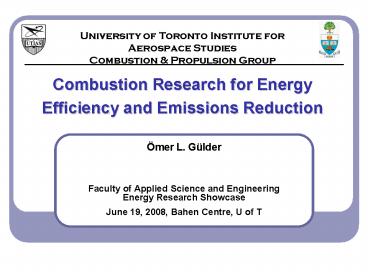Combustion Research for Energy Efficiency and Emissions Reduction - PowerPoint PPT Presentation
1 / 17
Title:
Combustion Research for Energy Efficiency and Emissions Reduction
Description:
Carbon/particulate matter formation in high-pressure combustion ... Why carbon/particulate matter forms in combustion? Influence of pressure ... – PowerPoint PPT presentation
Number of Views:43
Avg rating:3.0/5.0
Title: Combustion Research for Energy Efficiency and Emissions Reduction
1
Combustion Research for Energy Efficiency and
Emissions Reduction
University of Toronto Institute for Aerospace
Studies Combustion Propulsion Group
- Ömer L. Gülder
- Faculty of Applied Science and Engineering
- Energy Research Showcase
- June 19, 2008, Bahen Centre, U of T
2
What is combustion?
- Complex interaction of
- Physical processes
- Fluid dynamics, heat and mass transfer
- Chemical processes
- Thermodynamics, chemical kinetics
- Practical applications also involve
- Aerodynamics
- Fuel technology
- Mechanical/chemical engineering.
3
What does it do?
- Key element of many of modern societys critical
technologies - Accounts for more than 80 percent of the worlds
energy usage - Vital to our current way of life
- Spacecraft and aircraft propulsion, electric
power production, home heating, ground
transportation, and materials processing all use
combustion to convert chemical energy to thermal
energy or propulsive force
4
What does it do?
- CO2 emissions
- NOx emissions
- Particulate matter emissions
- CO
- HC
- Sulfur compounds
5
Objectives of combustion research
- Improve energy efficiency
- Reduce CO2
- Reduce unburned HC and PM
- Reduce pollutant emissions
- NOX
- CO
- Sulfur compounds
6
Combustion research at UTIAS
- Carbon/particulate matter formation in
high-pressure combustion - Lean-premixed and hydrogen-enriched combustion
- Combustion in zero-gravity
- Alternative jet fuels / biofuels
- Jet fuel thermal stability
- Laser-based combustion diagnostics development
7
Carbon/particulate matter formation at
high-pressures
8
Carbon/particulate matter formation at
high-pressures
- Why carbon/particulate matter forms in
combustion? - Influence of pressure
- Carbon formation could be prevented?
- Influence of fuel chemistry
9
Lean-premixed and hydrogen-enriched combustion
- Energy efficiency can be improved by
lean-premixed combustion in gas turbines - Better control of NOx emissions
- No carbon/PM emission
10
Alternative jet fuels / biofuels
11
Alternative jet fuels / biofuels
- Bio-fuels were believed to reduce GHG emissions
through CO2 sequestration by the growth of
feedstock - However, most recent findings imply that carbon
savings depend on how bio-fuels are produced - When land clearance is taken into account, all
major bio-fuels cause massive increases in GHG
emissions
12
Alternative jet fuels / biofuels
13
General criteria to assess alternative jet fuels
- Energy economics, production cost and
availability - Ground infrastructure, distribution
- Impact on aircraft (mass, aerodynamics, range,..)
- Fuel handling and thermal stability
- Combustion characteristics and emissions
14
Economics, production cost and availability
- In US, Canada, and EU-15 countries between 30 to
70 of current crop area should be devoted to
bio-fuel production to replace 10 of their
transport fuels - Emissions of nitrous oxide, N2O, from nitrogen
fertilizers negates all the carbon savings
achieved by replacing fossil fuels
15
Combustion at zero-gravity
- Benchmark measurements in flames are hindered by
buoyancy due to gravity - Buoyancy effects disappear at zero-gravity
- Flame stability and carbon formation can be
investigated effectively
16
Jet fuel thermal stability
- Fuel is used as a coolant before it reaches the
injectors and burns in combustion chamber - If fuel temperature exceeds a certain value, fuel
starts thermally decomposing and forming deposits - Deposits can plug the injector passages and cause
undesirable carbon deposits - Research focus Prevention of fuel thermal
degradation
17
Combustion research at UTIAS funded by
- NSERC
- CFI
- Auto 21 NCE
- Canadian Space Agency
- Pratt and Whitney Canada































